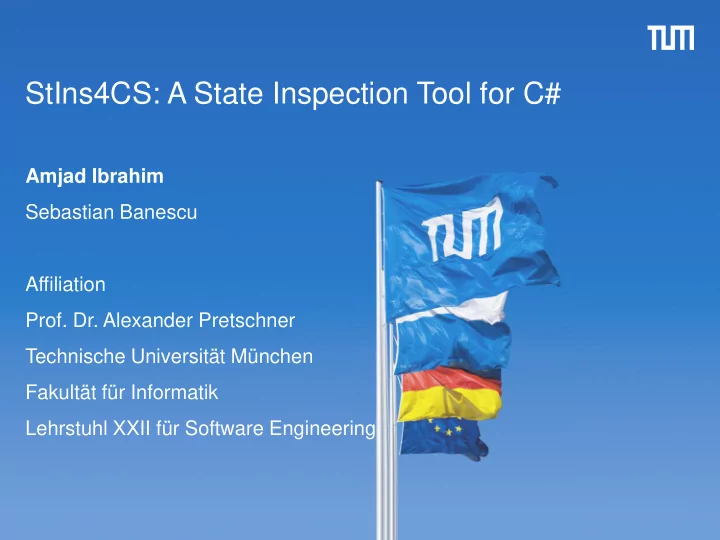

StIns4CS: A State Inspection Tool for C# Amjad Ibrahim Sebastian Banescu Affiliation Prof. Dr. Alexander Pretschner Technische Universität München Fakultät für Informatik Lehrstuhl XXII für Software Engineering 1
INTRODUCTION
Software Tampering Context : Running an application on a platform controlled by an adversary Attacks : Unauthorized modification of software Consequence : Retail value of pirated software is $63 billion in 2013 [13]
How to protect a software Obfuscation Tamper-Proofing Software Protection (Falcarin et al. [6]) Watermarking Birthmarking
Contributions • The design and implementation of StateInspection4CSharp tool. • Symbolic execution to generate the set of input-output pairs for a certain set of functions. • Evaluation of the performance and stealth of StIns4CS with various response mechanisms. • A method to increase the stealth of the response mechanism by degrading results.
StIns4CS
The Concept Tamper-proofed Source StIns4CS Source Code Code C# C# • State Inspection [4] { { • Integrity of pure functions • Random networks of guards • A configurable response mechanism
Guard
Code Guard Network Original Methods Shuffled Methods [F1, F2, F3, F4, F5, F6, F7, F8] [F3, F2, F7, F1, F6, F8, F4, F5] F3 F6 F2 F1 F5 F8 F7 F4
Stack Inspection Stack overflow
Transformation Workflow Checkers Method Checkers Static Code Responders Networks assertions Creation and Analysis Insertion Generation Generation insertion • Responses in case of detecting a tampering • Immediate crash • Delayed crash • Do nothing • Remote logging
Primitive combination • Sabotaging the return values • Incorporating results of the check with return value Benefits 1. Hides the comparison 2. Hides the response 3. Adds diversity to the protection code
Primitive combination- Example return result.Substring(expected-output);
EVALUATION • Effectiveness against static and dynamic patching • Stealth of checking code • Cost of checking
Effectiveness against code patching • Verify how the applications respond to patching • Static code patching • Dynamic memory patching • Test variable: • Component size
Discussion n = 2
Discussion n = 4 Patching detected in at least n-1 places
Disabling a check n = 4
Stealth of checking code • Pattern matching attacks • Test variables • Primitive combination • Virtualization obfuscation • Three regular expressions: • Regex1: any if-statement • Regex2: if-statement with stack inspection • Regex3: response call statement
Discussion Regex2 Regex3 Regex1
Results 100 100 100 100 100 90 Accuracy in matching checks 80 70 60 50 50 50 40 30 20 15 15 10 0 0 0 0 0 Test Case1 Test Case2 Test Case3 Test Case4
Cost of checking • Function invocations added performance will be affected • Execution time • Memory allocation • Code size
Execution time and memory allocation Memory Allocation Impact Execution Time Impact • Directly proportional to component size 70 0.5 Memory allocation in megabyte 45 0.45 60 • No guarantee on degradation. 40 Execution time in msec 0.4 50 0.35 35 • Depends on the nature of the program 0.3 30 40 • Configuration 0.25 Function 1 25 Function 1 30 0.2 Function 2 20 Function 2 0.15 20 Function 3 15 Function 3 0.1 10 10 0.05 5 0 0 0 0 2 4 8 16 0 2 4 8 16 Component size Component size
CONCLUSION & FUTURE WORK
Conclusion • Effectiveness of the approach • StIns4CS • Solving problems affect stealth • Stack inspection • Enhancing the stealth is possible • Primitive combination
Future work • Stack inspection other options to break cycles • Information from the code call graph • Primitive combination is conditioned • Generalizing this concept • Software-diversity techniques within the checks • Versions of the same test
Thanks for your attention ibrahim@in.tum.de QUESTIONS!
References [1] Chang, Hoi, and Mikhail J. Atallah. “Protecting Software Code by Guards.” In Security and Privacy in Digital Rights Management, 160 – 175. Springer, 2002. [2]. Horne, Bill, Lesley Matheson, Casey Sheehan, and Robert E. Tarjan. “Dynamic Self -checking Techniques for Improved Tamper Resistance.” In Security and Privacy, 141– 159. Springer, 2002. [3]. Giffin, Jonathon T., Mihai Christodorescu, and Louis Kruger. “Strengthening Software Self - checksumming via Self- modifying Code.” In Computer Security Applications Conference, 21st Annual, 10– pp, 2005. [4]. Mavrogiannopoulos, Nikos, Nessim Kisserli, and Bart Preneel. “A Taxonomy of Self -modifying Code for obfuscation.” Computers & Security 30, 2011. [5]. David Aucsmith , “Tamper resistant software: an implementation”, in information hiding, 199 [6] P. Falcarin, C. Collberg, M. Atallah, and M . Jakubowski. Guest editors’ introduction: Software protection. Software, IEEE, 28(2):24 – 27, 2011. [7]. L. Martignoni, R. Paleari, and D. Bruschi. Conqueror: tamper-proof code execution on legacy systems. In Proceedings of the 7th Conference on Detection of Intrusions and Malware and Vulnerability Assessment (DIMVA), Lecture Notes in Computer Science. Springer, July 2010.
References [8]. J. Qiu, B. Yadegari, B. Johannesmeyer, S. Debray , X. Su, “Identifying and Understanding Self -Checksumming Defenses in Software”, 2015 . [9]. A. Seshadri , M. Luk , E. Shi , A. Perrig , L. van Doorn , P. Khosla , “Pioneer: verifying code integrity and enforcing untampered code execution on legacy systems”, Proceedings of the twentieth ACM symposium on Operating systems principles, 2005. [10]. G. Tan, Y. Chen, M.H. Jakubowski , ”Delayed and controlled failures in tamper - resistant systems”, 8th Information Hiding, Lecture Notes in Computer Science, LNCS, vol. 4437 (2006). [11]. G. Wurster , P. C. van Oorschot , A. Somayaji , “A Generic Attack on Checksumming- Based Software Tamper Resistance”, 2005 IEEE Symposium on Security and Privacy. [12] Collberg, Christian,“Surreptitious software obfuscation, watermarking, and tamperproofing for software protection, 2010. [13] S. Smith and S. Weingart. Building a high performache programmable secure coprocessor.Computer Networks,1999. [14] Steve R. White and Liam Comerford. ABYSS: An architecture for software protection. IEEE Transactions on Software Engineering,1990. [15] Bennett Yee and J. D. Tygar. Secure coprocessors in electronic commerce applications. 1995. [16]. http://globalstudy.bsa.org/2011/downloads/study_pdf/2011_BSA_Piracy_Study-InBrief.pdf [17]. http://research.microsoft.com/en-us/projects/pex/ [18]. http://roslyn.codeplex.com [19]. https://dzone.com/articles/smart-continuous-delivery
Recommend
More recommend